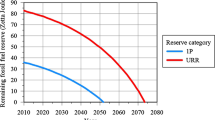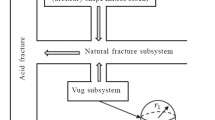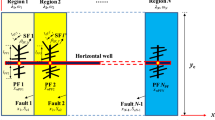Abstract
More and more attention has been paid to the study of flow properties in fractured-vuggy reservoirs because lots of such reservoirs have been found worldwide with significant gas production and reserves. In order to improve carbonate gas reservoir production, highly deviated wells (HDW) are widely used in the field. However, it is very difficult to consider the complex pore structure of fractured-vuggy reservoirs and evaluate the pressure transient behaviors of HDW. This paper presents a semi-analytical model that analyzed the pressure behavior of HDW in fractured-vuggy carbonate gas reservoirs which consist of fractures, vugs and matrix. Introducing pseudo-pressure; Fourier transformation, Laplace transformation, and Stehfest numerical inversion were employed to establish a point source and line source solutions. Furthermore, the validity of the proposed model was verified by comparing with two existing pressure transient models. Then the flow characteristics were analyzed thoroughly by examining the pressure derivative curve which can be divided into five flow stages. The physical meanings of the model parameters were analyzed through sensitivity analysis. Finally, a field case was successfully used to show the application of the proposed semi-analytical model. The study contributes to the highly efficient evaluation of the pressure transient behaviors for HDW in fractured-vuggy carbonate gas reservoirs.
Access this chapter
Tax calculation will be finalised at checkout
Purchases are for personal use only
Similar content being viewed by others
Abbreviations
- \(C\) :
-
Wellbore storage coefficient, \(m^{3} /MPa\)
- \(C_{t}\) :
-
Total Compressibility, \(MPa^{ - 1}\)
- \(h\) :
-
Formation thickness, \(m\)
- \(k\) :
-
Permeability, \(md\)
- \(L_{w}\) :
-
High deviated well length, \(m\)
- \(m\) :
-
Pseudo pressure, \(MPa\)
- \(m_{w}\) :
-
Well bottom-hole pseudo pressure, \(MPa\)
- \(p\) :
-
Pressure, \(MPa\)
- \(p_{wf}\) :
-
Well bottom-hole pressure, \(MPa\)
- \(p_{sc}\) :
-
Pressure at standard condition, \(MPa\)
- \(\widetilde{q}\) :
-
Production rate from point source, \(m^{3} /d\)
- \(q_{g}\) :
-
Gas production rate, \(m^{3} /d\)
- \(q_{gj}\) :
-
Simulated production rate from the proposed model, \(m^{3} /d\)
- \(\mathop {q_{gj} }\limits^{\sim }\) :
-
Field production rate, \(m^{3} /d\)
- \(r\) :
-
Radial distance, \(m\)
- \(r_{w}\) :
-
Wellbore radius, \(m\)
- \(r_{e}\) :
-
Formation radius, \(m\)
- \(S\) :
-
Skin factor
- \(s\) :
-
Laplace transform variable
- \(t\) :
-
Time, day
- \(T\) :
-
Reservoir temperature, \(k\)
- \(T_{sc}\) :
-
Temperature at standard condition, \(k\)
- \(x,y,z\) :
-
Directional coordinates
- \(x_{w} ,y_{w} ,z_{w}\) :
-
Distance of mid-perforation in x, y and z coordinates, \(m\)
- \(Z\) :
-
Z-factor of gas, dimensionless
- \(\alpha_{c} ,\alpha_{m}\) :
-
Shape factors of vugs and matrix, \({1 \mathord{\left/ {\vphantom {1 {m^{2} }}} \right. \kern-\nulldelimiterspace} {m^{2} }}\)
- \(\lambda\) :
-
Interporosity flow coefficient, dimensionless
- \(\omega\) :
-
Storativity ratio, dimensionless
- \(\theta\) :
-
Inclination angle, degree
- \(\phi\) :
-
Porosity, fraction
- \(\mu_{g}\) :
-
Gas viscosity, \(mPa \cdot s\)
- \(\alpha_{p}\) :
-
Constant, \(\alpha_{p} = 1.842\)
- \(c\) :
-
Vugs system
- \(f\) :
-
Fractures system
- \(m\) :
-
Matrix system
- \(h\) :
-
Horizontal direction
- \(i\) :
-
Initial condition
- \(j\) :
-
Initial condition
- \(v\) :
-
Vertical direction
- \(D\) :
-
Dimensionless
- \(\overline{{~}}\) :
-
Laplace domain
- \(\widehat{{~}}\) :
-
Fourier domain
- \(\sim\) :
-
Field production data
References
Li, Y., Wang, Q., Li, B.Z., Liu, Z.L.: Dynamic characterization of different reservoir types for a fractured-caved carbonate reservoir. In: SPE Kingdom of Saudi Arabia Annual Technical Symposium and Exhibition, SPE-188113-MS, Dammam, Saudi Arabia (2017)
Ghahri, P., Jamiolahmady, M.: A new, accurate and simple model for calculation of productivity of deviated and highly deviated well–Part I: single-phase incompressible and compressible fluid. Fuel 97, 24–37 (2012)
Warren, J.E., Root, P.J.: The behavior of naturally fractured reservoirs. SPE J. 3(3), 245–255 (1963)
Abdassah, D., Ershaghi, I.: Triple-porosity systems for representing naturally fractured reservoirs. SPE Form. Eval. 1(2), 113–127 (1986)
Camacho-Velazquez, R., Vasquez-Cruz, M., Castrejon-Aivar, R., et al.: Pressure transient and decline curve behaviors in naturally fractured vuggy carbonate reservoirs. In: SPE Annual Technical Conference and Exhibition, SPE-77689-MS, San Antonio, Texas, USA (2002)
Gulbransen, F., Hauge, V.L., Lie, K.A.: A multiscale mixed finite element method for vuggy and naturally fractured reservoirs. SPE J. 15(2), 395–403 (2010)
Jia, Y.L., Fan, X.Y., Nie, R.S., et al.: Flow modeling of well test analysis for porous-vuggy carbonate reservoirs. Transp. Porous Media 97(2), 253–279 (2013)
Zhang, F.S., An, M.K., Yan, B.C., et al.: Modeling the depletion of fractured vuggy carbonate reservoir by coupling geomechanics with reservoir flow. In: SPE Reservoir Characterisation and Simulation Conference and Exhibition, SPE-186050-MS, Abu Dhabi, UAE (2017)
Du, X., Lu, Z.W., Li, D.M., et al.: A novel analytical well test model for fractured vuggy carbonate reservoirs considering the coupling between oil flow and wave propagation. J. Nat. Gas Sci. Eng. 173, 447–461 (2019)
Cinco-Ley, H., Ramey Jr., H.J., Miller, F.G.: Pseudo-skin factors for partially-penetrating directionally-drilled wells. In: Fall Meeting of the Society of Petroleum Engineers of AIME, SPE-5589-MS, Dallas, Texas, USA (1975)
Besson, J.: Performance of slanted and horizontal wells on an anisotropic medium. In: European Petroleum Conference, SPE-20965-MS, The Hague, The Netherlands (1990)
Abbaszadeh, M., Hegeman, P.S.: Pressure-transient analysis for a slanted well in a reservoir with vertical pressure support. SPE Form. Eval. 5(3), 277–284 (1990)
Ozkan, E., Raghavan, R.: A computationally efficient, transient-pressure solution for inclined wells. In: SPE Annual Technical Conference and Exhibition, SPE-49085-MS, New Orleans, Louisiana, USA (1998)
Meng, F.K., Lei, Q., He, D.B., et al.: Production performance analysis for deviated wells in composite carbonate gas reservoirs. J. Nat. Gas Sci. Eng. 56, 333–343 (2018)
Dong, W.X., Wang, X.D., Wang, J.H.: A new skin factor model for partially penetrated directionally-drilled wells in anisotropic reservoirs. J. Petrol. Sci. Eng. 161, 334–348 (2018)
Wang, K., et al.: Analysis of gas flow behavior for highly deviated wells in naturally fractured-vuggy carbonate gas reservoirs. Math. Prob. Eng. 2019, 1–13 (2019)
Wang, L., Chen, X., **a, Z.: A novel semi-analytical model for multi-branched fractures in naturally fractured-vuggy reservoirs. Sci. Rep. 8(1), 11586 (2018)
Al-Hussainy, R., Ramey, H.J., Jr., Crawford, P.B.: The flow of real gases through porous media. J. Petrol. Technol. 18(5), 624–636 (1966)
Stehfest, H.: Algorithm 368: numerical inversion of Laplace transforms [D5]. Commun. ACM 13(1), 47–49 (1970)
Samuel, G.R., Liu, X.: Advanced Drilling Engineering: Principles and Designs. Gulf Pub, Houston (2009)
Nelder, J.A., Mead, R.: A simplex method for function minimization. Comput. J. 7(4), 308–313 (1965)
Author information
Authors and Affiliations
Corresponding author
Editor information
Editors and Affiliations
Appendices
Appendix A. Calculation of Pseudo-pressure
In Eqs. (1)–(7), \(m_{f}\), \(m_{m}\), \(m_{c}\) is the pseudo-pressure of the fracture system, matrix system and vugs system, respectively, \(MPa/s\). The pseudo-pressure can be given as follows:
Appendix B. Calculation of Continuous Point Source Solution
Equations (8)–(14) can be transformed into Laplace domain by the Laplace transformation.
The dimensionless governing equations of fractures, matrix and vugs systems in the Laplace domain are as follows:
The outer boundary condition is transformed as:
The inner boundary condition is transformed as:
The top and bottom boundaries are transformed as:
Where
To eliminate the variable \(z_{D}\) in the governing equation, Eqs. (B.1)–(B.5) can be transformed by Fourier cosine transform. The Fourier cosine transform and inverse Fourier cosine transform are given as follows:
Where
By employing the Fourier cosine transform (Eq. (B8)), Eqs. (B.1)–(B.5) can be transformed as follows:
Where
The outer boundary condition is transformed as:
The inner boundary condition is transformed as:
Then Eq. (B.11) can be transformed to a modified Bessel function of zero order, like this:
The general solution of Eq. (B.16) is given as follows:
Based on the outer and inner boundary conditions (Eq. (B14)–(B.15)), the solution in Laplace domain can be obtained by inverse Fourier cosine transform as follows:
Rights and permissions
Copyright information
© 2022 The Author(s), under exclusive license to Springer Nature Singapore Pte Ltd.
About this paper
Cite this paper
Zhang, YY., Li, SS., Li, L. (2022). Pressure Transient Characteristics of Highly Deviated Wells in Fractured-Vuggy Carbonate Gas Reservoirs. In: Lin, J. (eds) Proceedings of the International Field Exploration and Development Conference 2021. IFEDC 2021. Springer Series in Geomechanics and Geoengineering. Springer, Singapore. https://doi.org/10.1007/978-981-19-2149-0_160
Download citation
DOI: https://doi.org/10.1007/978-981-19-2149-0_160
Published:
Publisher Name: Springer, Singapore
Print ISBN: 978-981-19-2148-3
Online ISBN: 978-981-19-2149-0
eBook Packages: Earth and Environmental ScienceEarth and Environmental Science (R0)




